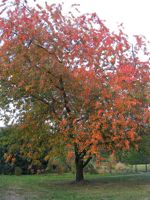Mon-Fri 9am - 5pm Mountain time
Black Cherry vs Water Birch (Red Birch)
Betula occidentalis
Prunus serotina
CUSTOM GROW
NOT AVAILABLE THIS SEASON - MIGHT RETURN
Water Birch, also known as Red Birch, is a waterside plant native to western North America. This multi-stemmed species is ideal for wetlands. It tolerates being planted in heavy clay and wet soil conditions.
This tree grows small enough for yards with limited space.
It is an attractive ornamental with reddish non-peeling bark.
Note: Unfortunately this difficult to grow species is not currently scheduled to grow at TreeTime.ca. Perhaps try purchasing seed from SeedTime.ca and growing your own? Or sign up for a restock notification above.
Black Cherry is common in eastern North America but a rare find elsewhere. This tree is shade tolerant and is often found in old fields, forest openings, and along fencerows.
The fruit is edible and is commonly used to flavor rum and brandy. It is also edible and often eaten fresh or used in wine or jelly. Black Cherry trees typically begin producing fruit when they are 10 years of age.
Black Cherry wood is a rich reddish-brown color and is strong, making it valued in cabinetry and woodworking. It is often used in reclamation as well.
The leaves can poison livestock as they contain cyanide derivatives and precursors. However, many have noted that deer still seem to browse their trees with impunity and birds and other animals eat the fruit when available.
Water Birch (Red Birch) Quick Facts
Black Cherry Quick Facts
Toxicity: bark and wilted leaves toxic to livestock

